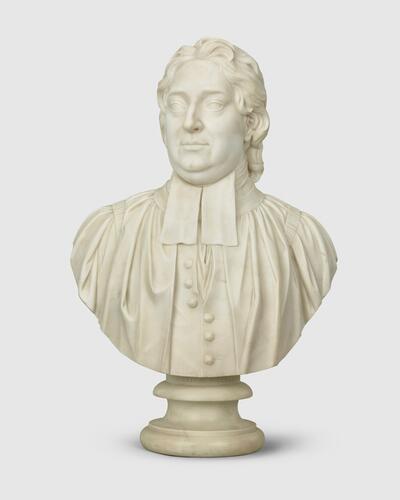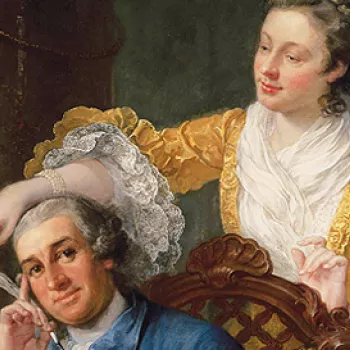William Wollaston (1660-1724) 1730-31
Marble | 75.0 x 50.5 x 30.0 cm (including base/stand) | RCIN 1390
-
A white marble bust of William Wollaston with his head turned slightly to the left, wearing clerical dress, the three top buttons of his jacket undone below the collar. The bust rests on a circular socle.
This bust was made after a terracotta or fired-clay model which the sculptor Giovanni Battista Ghelphi gave to the architect William Kent as a gift before his return to Italy. The terracotta model is now missing.
William Wollaston was a great English theologian greatly admired by Queen Caroline, consort of King George II. Wollaston became famous with the publication of his work The religion of nature delineated published in 1722 and 1724, which explored the origins of morality, ethics and the good following a highly rational and logical approach. His work was greatly influenced by the ideas of Sir Isaac Newton and it had a great impact in theological thinking of the period.
Although essentially a private commission for the grounds of a royal palace, the Hermitage designed for Queen Caroline by William Kent (1685-1748) and constructed at Richmond in 1731-2 achieved immediate fame through the contemporary press because of the ‘royal honour’ it afforded to the memory of these five ‘Men of Learning and publick Virtue’. Queen Caroline seems to have been the first in this country to have erected a building which was chiefly intended for portrait sculptures of ‘great men’, and the fact that they were near-contemporary, British men of thought rather than ancient men of arms lent further novelty to the scheme. The Hermitage stood for only twenty years but its appearance can be well understood from drawings and contemporary accounts. It was set into a hillside and the single external façade was formed of rough masonry so as to resemble that of an ancient, semi-ruined structure. This concealed an ample interior divided into three main spaces. A small vestibule led into an octagonal hall, where four of these busts – Newton, Locke, Clarke and Woollaston – were placed in niches. The bust of Boyle had a place of special honour, on a circular altar, his head surrounded by a radiating sun.
In 1731 George Vertue noted that ‘Sigr Guelphi’ had received an order for four busts for Richmond. G.B. Guelfi, who was probably born in Rome, spent some time in the workshop of Camillo Rusconi. It was in Rome that Guelfi encountered William Kent, who was to be his link with English clients such as Thomas Fermor, 2nd Baron Leominster, for whom the sculptor was working in 1721 on the restoration of ancient sculptures from the Arundel collection. His commission for the Richmond project may have come via Lord Burlington, for whom Kent and Guelfi had recently been working. The busts are all posthumous, obliging the sculptor to make use of engraved likenesses for his models. An initial account for four sculptures was paid in September 1732. The bust of Boyle was paid for separately as part of an account which included the restoration of an antique statue of Venus.
As a celebratory memorial to scientific ‘worthies’ the Hermitage can be distinguished from contemporary endeavours such as Lord Cobham’s Temple of British Worthies at Stowe, also designed by Kent and completed in 1734-5, where Newton and Locke stood with figures from the more distant past. The favour accorded to Robert Boyle, whose bust stood at the centre, somewhat higher than the others and with a radiating sun behind his head, may be taken to represent the Queen’s estimation of the chemist, physicist, philosopher and founder member of the Royal Society. All five men were concerned with questions of physics and metaphysics, with the application of human reason – itself seen as a divine gift – in support of the fundamental Christian beliefs.
Boyle’s position at the centre of the group divided the others into two pairs: to one side stood Sir Isaac Newton, whom Queen Caroline when Princess of Wales had entertained at St James’s in 1716 and who ‘shew’d the World was philosophically and mathematically made; and that it could be framed and held together by none but an infinitely Wise and Almighty architect’. Next to Newton stood John Locke, who was championed for his knowledge of ‘the Powers and Operations of the Mind’, and whose Essay Concerning Humane Understanding (1689) was judged ‘the best Book of Logic in the World.’
The metaphysician Samuel Clarke, a correspondent of Leibniz, had presented Caroline with copies of his books shortly after her first arrival in England as Princess of Wales in 1714, and she, having read them swiftly, declared ‘Dr Clarke shall be one of my favourites; his writings are the finest things in the world’. His bust was paired at Richmond with that of his disciple William Wollaston, author of the widely-circulated The Religion of Nature delineated (1724).
In April 1733 the Gentleman’s Magazine announced a competition for verses on the subject of the Hermitage and its occupants, and in successive numbers of the magazine, with few exceptions, the anonymous authors competed in praise of Queen Caroline’s achievement. A common theme was her having favoured British philosophers over those of her native German lands, notably Leibniz.
Locke, Newton, Clarke and Woollaston were, the Magazine declared, ‘the Glory of their Country, and stamp’d a Dignity on human Nature…These great and worthy Men the Queen hath delighted to honour, and is the first crown’d Head in the World, who had uncommon Virtue enough to immortalize Men so absolutely in the Interests of Mankind, that all their political Principles were cultivated for their Good … When her Majesty consecrated these dead Heroes, she built herself a Temple in the Hearts of the People of England’.
Text adapted from The First Georgians: Art and Monarchy 1714 - 1760, London, 2014Provenance
Made for Queen Caroline's Grotto at Richmond by Guelphi. Subsequently at Buckingham House. Sent from there to Riding House Stores in 1828, then on to Windsor Castle. Moved to Kensington Palace in 1923.
-
Creator(s)
Acquirer(s)
-
Medium and techniques
Marble
Measurements
75.0 x 50.5 x 30.0 cm (including base/stand)
60.0 x 50.5 x 30.0 cm (excluding base/stand)
Category
Object type(s)
Bibliographic reference(s)
Gordon Balderston / 'Giovanni Battista Guelfi: five busts for Queen Caroline's Hermitage in Richmond / Sculpture Journal Volume 17 Number 1 / 2008 p 83-88











